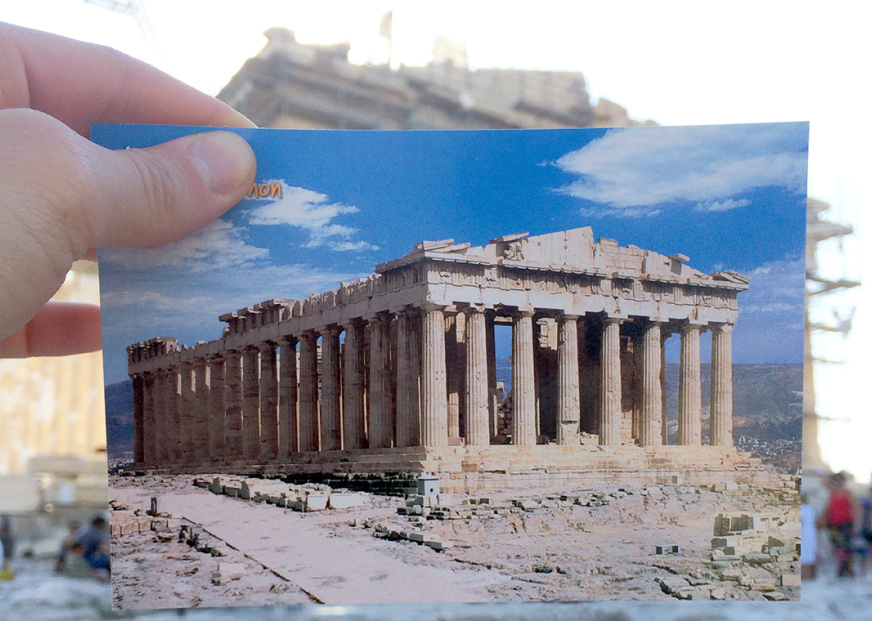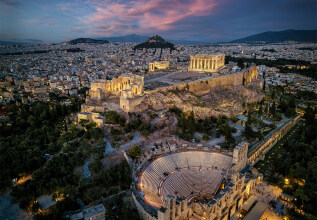8 MIN
TRAVEL TIPS
Guide to Visiting Athens

 Athens is also a great jumping off point to other parts of Greece. If you plan on visiting any of the Greek Islands be sure to compare cost and duration between taking a ferry versus flying (Aegean Airlines has the most extensive network of flights) – sometimes spending a little more can save you a lot of time. In addition, one of the things that surprised me the most about Athens is how compact the city’s historic center is (if you’ve been to Italy, think Florence versus Rome). That works out to your benefit as most of the main sights are easily reachable on foot. You can fill in gaps using public transportation, but you’ll most likely find that won’t be necessary if you strategically cluster your sightseeing.
What to See and Do
Athens is saturated with so much cultural richness and charm that the city itself feels like a living museum. It’s no surprise that the top site for most visitors is Acropolis Hill (which sits high above the city and is crowned by the iconic Parthenon), and your admission ticket also includes free entry to 6 other archeological sites such as the Ancient Agora, Theatre of Dionysus and Temple of Olympian Zeus. Nearby you can also climb to the top of Mars Hill (the spot where the Apostle Paul preached to the Athenians) for a striking 360-degree view of the Acropolis and surrounding cityscape.
Athens is also a great jumping off point to other parts of Greece. If you plan on visiting any of the Greek Islands be sure to compare cost and duration between taking a ferry versus flying (Aegean Airlines has the most extensive network of flights) – sometimes spending a little more can save you a lot of time. In addition, one of the things that surprised me the most about Athens is how compact the city’s historic center is (if you’ve been to Italy, think Florence versus Rome). That works out to your benefit as most of the main sights are easily reachable on foot. You can fill in gaps using public transportation, but you’ll most likely find that won’t be necessary if you strategically cluster your sightseeing.
What to See and Do
Athens is saturated with so much cultural richness and charm that the city itself feels like a living museum. It’s no surprise that the top site for most visitors is Acropolis Hill (which sits high above the city and is crowned by the iconic Parthenon), and your admission ticket also includes free entry to 6 other archeological sites such as the Ancient Agora, Theatre of Dionysus and Temple of Olympian Zeus. Nearby you can also climb to the top of Mars Hill (the spot where the Apostle Paul preached to the Athenians) for a striking 360-degree view of the Acropolis and surrounding cityscape.


 There’s also a museum for every interest in Athens, the largest being the National Archeological Museum, which boats an expansive collection of Greek art and artifacts from around the country. Others include the Acropolis Museum, a stunning architectural structure that houses the surviving fragments from Acropolis Hill (I recommend visiting the museum first to help put the site into context), the Benaki Museum of Greek History and Culture, Museum of Cycladic Art and many more.
There’s also a museum for every interest in Athens, the largest being the National Archeological Museum, which boats an expansive collection of Greek art and artifacts from around the country. Others include the Acropolis Museum, a stunning architectural structure that houses the surviving fragments from Acropolis Hill (I recommend visiting the museum first to help put the site into context), the Benaki Museum of Greek History and Culture, Museum of Cycladic Art and many more.
 Other sights to put on your radar include the National Gardens (a 38-acre public park that’s perfect for exploring), Panathenaic Stadium (a restored 60,000-seat stadium that played host to the first modern Olympic games in 1896), Church of Panagia Kapnikarea (the oldest Greek Orthodox church in Athens) and Syntagma Square (anchored by the neoclassical Greek parliament building featuring an entertaining changing of the guard ceremony every hour on the hour).
Other sights to put on your radar include the National Gardens (a 38-acre public park that’s perfect for exploring), Panathenaic Stadium (a restored 60,000-seat stadium that played host to the first modern Olympic games in 1896), Church of Panagia Kapnikarea (the oldest Greek Orthodox church in Athens) and Syntagma Square (anchored by the neoclassical Greek parliament building featuring an entertaining changing of the guard ceremony every hour on the hour).
 You should also spend time in Athens’ central Plaka neighborhood with its historic old world feel and labyrinth of winding streets, perfect for shopping and strolling. Other shopping spots include the flea market near Monstriaki Square.
You should also spend time in Athens’ central Plaka neighborhood with its historic old world feel and labyrinth of winding streets, perfect for shopping and strolling. Other shopping spots include the flea market near Monstriaki Square.
 Where to Eat and Drink
Greek food is easy to fall in love with. Most of what you’ll encounter is rooted in an ensemble of simple ingredients including fresh produce (especially tomatoes and eggplant), grilled meats, seafood, olives and cheeses. Seriously, who knew that feta could be prepared so many different ways… We had some of our most memorable eating experiences at tavernas (rustic neighborhood restaurants with a limited menu) where we would order an assortment of small sharable plates called mezedes. This made is so we were able to try a variety of things without spending a lot. And without fail, we ordered a traditional Greek salad every single night with dinner. We had heard that the Greeks typically dine late around 10pm, but generally encountered decent crowds as early as 7 or 8pm.
In Athens, you’ll find tons of places to places to eat and drink throughout the Plaka and surrounding neighborhoods. One of the places we ate was a small restaurant tucked into a quiet side street, just steps from Acropolis Hill. Oozing with ambiance, we sat at one of the outdoor tables that lined the cozy alleyway, surrounded by trees, flower boxes and lights. The service was super laid back and very friendly, surprising considering we were in the heart of tourist Athens. We ordered a carafe of aromatic house white wine, the meatballs with “the” sauce (which had a hint of savory sweetness) and arguably one of our favorite Greek salads of the entire trip, topped with a big salty block of feta. We finished the meal with ouzo (a strong anise-flavored liquor) and Greek coffee (made with loose grounds that settle at the bottom of the cup. As the waiter brought my coffee a little dripped onto its saucer, which he said is believed to be good luck. As the crowd grew more tables were added to the street so the restaurant never felt empty. Then came the accordion player who cheerfully serenaded the diner crowd. When we got the check we were surprised that our entire meal was under 30 euros. Delicious and affordable.
Where to Eat and Drink
Greek food is easy to fall in love with. Most of what you’ll encounter is rooted in an ensemble of simple ingredients including fresh produce (especially tomatoes and eggplant), grilled meats, seafood, olives and cheeses. Seriously, who knew that feta could be prepared so many different ways… We had some of our most memorable eating experiences at tavernas (rustic neighborhood restaurants with a limited menu) where we would order an assortment of small sharable plates called mezedes. This made is so we were able to try a variety of things without spending a lot. And without fail, we ordered a traditional Greek salad every single night with dinner. We had heard that the Greeks typically dine late around 10pm, but generally encountered decent crowds as early as 7 or 8pm.
In Athens, you’ll find tons of places to places to eat and drink throughout the Plaka and surrounding neighborhoods. One of the places we ate was a small restaurant tucked into a quiet side street, just steps from Acropolis Hill. Oozing with ambiance, we sat at one of the outdoor tables that lined the cozy alleyway, surrounded by trees, flower boxes and lights. The service was super laid back and very friendly, surprising considering we were in the heart of tourist Athens. We ordered a carafe of aromatic house white wine, the meatballs with “the” sauce (which had a hint of savory sweetness) and arguably one of our favorite Greek salads of the entire trip, topped with a big salty block of feta. We finished the meal with ouzo (a strong anise-flavored liquor) and Greek coffee (made with loose grounds that settle at the bottom of the cup. As the waiter brought my coffee a little dripped onto its saucer, which he said is believed to be good luck. As the crowd grew more tables were added to the street so the restaurant never felt empty. Then came the accordion player who cheerfully serenaded the diner crowd. When we got the check we were surprised that our entire meal was under 30 euros. Delicious and affordable.

 We had another great meal at a Taverna which is located in the Psirri neighborhood north of Monstriaki Square, an area that’s popular for nightlife in Athens. It was a little early when we arrived, but don’t be discouraged if the restaurants look empty since many have “garden seating” in the back. Passing through the kitchen on the way to our table, the waiter invited us to observe the night’s special dishes to “see if anything inside looks good”. Of course it all did, but what sold us was the grilled vegetable stack made with fresh parsley, tomatoes, red bell pepper, zucchini, eggplant and potatoes. We ordered this along with a Greek salad (naturally), tzatziki dip, grilled feta topped with spicy paprika, a carafe of house white wine and a glass of ouzo. The restaurant filled up quickly and the lone waiter worked extra fast to make sure all of the tables were taken care of. We didn’t mind the slightly slower service since it was nice to sit back and enjoy an al fresco meal under a canopy of trees and stars, removed from the street and foot traffic passing by.
We had another great meal at a Taverna which is located in the Psirri neighborhood north of Monstriaki Square, an area that’s popular for nightlife in Athens. It was a little early when we arrived, but don’t be discouraged if the restaurants look empty since many have “garden seating” in the back. Passing through the kitchen on the way to our table, the waiter invited us to observe the night’s special dishes to “see if anything inside looks good”. Of course it all did, but what sold us was the grilled vegetable stack made with fresh parsley, tomatoes, red bell pepper, zucchini, eggplant and potatoes. We ordered this along with a Greek salad (naturally), tzatziki dip, grilled feta topped with spicy paprika, a carafe of house white wine and a glass of ouzo. The restaurant filled up quickly and the lone waiter worked extra fast to make sure all of the tables were taken care of. We didn’t mind the slightly slower service since it was nice to sit back and enjoy an al fresco meal under a canopy of trees and stars, removed from the street and foot traffic passing by.
 And for a midday break, I loved treating myself to an ice cold café frappe. Different than the sugary coffee beverages we are familiar with the United States, the Greek variation is strong and frothy with the option to add a hint of sugar or milk. I found it to be a great way to cool off and keep my sightseeing energy up.
Also Good to Know
Before our trip I also wondered if we would experience any language barrier trouble since the Greek alphabet looks more like symbols than the Latin letters we are familiar with (there’s a reason for the saying “It’s all Greek to me!”). To my relief, it was surprisingly easy to get around and communicate since most signs and menus were listed in both Greek and English, and the people we encountered were usually more than happy to help. Like any other place you may visit, it’s always a good idea to have a few basic words and phrases in your back pocket like kalimera (good morning), yasas (hi/bye), parakalo (please) and efcharisto (thank you).
And for a midday break, I loved treating myself to an ice cold café frappe. Different than the sugary coffee beverages we are familiar with the United States, the Greek variation is strong and frothy with the option to add a hint of sugar or milk. I found it to be a great way to cool off and keep my sightseeing energy up.
Also Good to Know
Before our trip I also wondered if we would experience any language barrier trouble since the Greek alphabet looks more like symbols than the Latin letters we are familiar with (there’s a reason for the saying “It’s all Greek to me!”). To my relief, it was surprisingly easy to get around and communicate since most signs and menus were listed in both Greek and English, and the people we encountered were usually more than happy to help. Like any other place you may visit, it’s always a good idea to have a few basic words and phrases in your back pocket like kalimera (good morning), yasas (hi/bye), parakalo (please) and efcharisto (thank you).
 artivle by boardingpasstraveler.com
see original article here
artivle by boardingpasstraveler.com
see original article here


